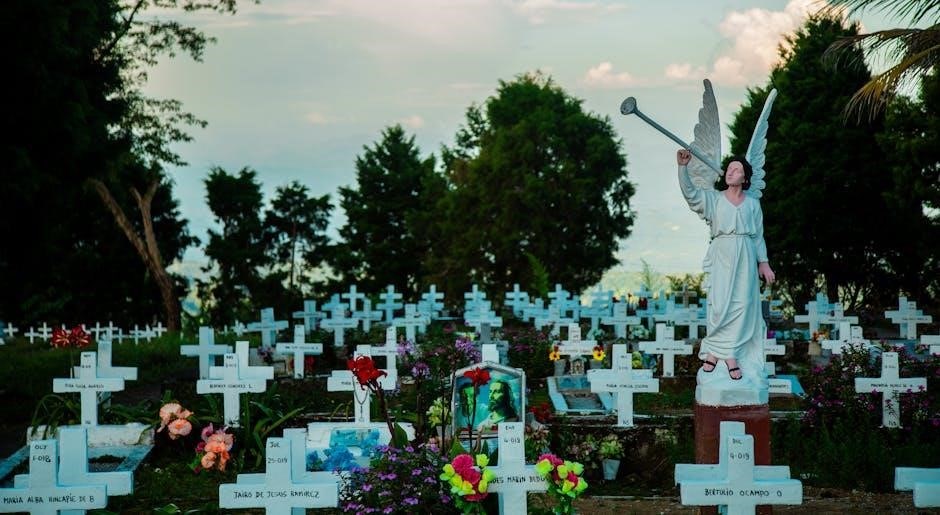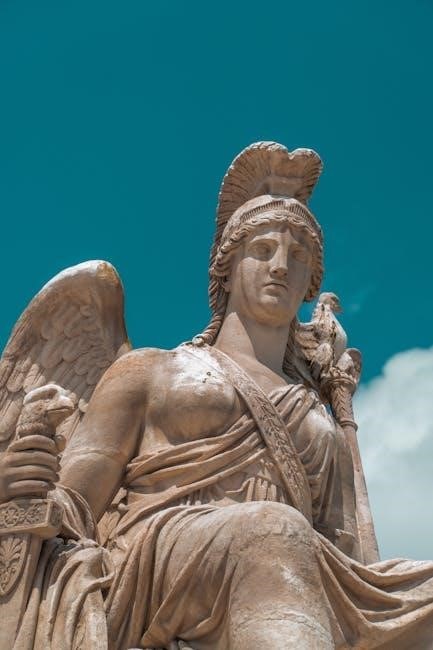Guido Reni’s Archangel Michael (1635) is a captivating Baroque oil painting depicting the triumph of good over evil, prominently displayed in Rome’s Santa Maria della Concezione․
1․1 Overview of the Painting
Guido Reni’s Archangel Michael (1635) is a monumental oil on canvas measuring 202 cm by 293 cm, housed in Rome’s Santa Maria della Concezione dei Cappuccini․ This Baroque masterpiece vividly portrays the archangel Michael triumphing over Satan, capturing the dramatic essence of their celestial battle․ Reni’s use of dynamic composition, luminous colors, and emotive expressions emphasizes the struggle between divine light and darkness․ The painting’s grand scale and theatrical style reflect Reni’s artistic genius, blending religious symbolism with intense emotional depth to create a powerful visual narrative of good’s victory over evil․
1․2 Historical Context and Significance
Guido Reni’s Archangel Michael was painted in 1635, a period marked by the Catholic Church’s efforts to reinforce its doctrine through art․ Commissioned by Cardinal Antonio Barberini, the painting reflects the Counter-Reformation’s emphasis on religious themes and the triumph of good over evil․ Reni’s masterpiece became a symbol of Catholic resilience and faith, embodying the Church’s struggle against heresy․ Its dramatic style and emotional depth resonated with 17th-century audiences, solidifying its place as a landmark of Baroque art and a powerful visual testament to Catholic devotion during a tumultuous era․

Creation and Background
Guido Reni’s Archangel Michael was created in 1635, commissioned by Cardinal Antonio Barberini․ This oil on canvas is housed in Santa Maria della Concezione dei Cappuccini, Rome, and hides certain secrets and scandal․
2․1 Date and Style
Guido Reni’s Archangel Michael was painted in 1635, during the height of the Italian Baroque period․ The work exemplifies Reni’s mastery of dramatic movement and emotional depth, blending vivid colors and dynamic composition to create a theatrical effect․ Reni’s style, often described as elegant and refined, contrasts with the intense energy of the scene, where Michael triumphs over Satan․ The painting’s grandeur and narrative power reflect the cultural and artistic trends of 17th-century Italy, making it a quintessential Baroque masterpiece․
2․2 Patronage and Commission
The painting was commissioned by Cardinal Antonio Barberini, brother of Pope Urban VIII, for a chapel in the Church of Santa Maria della Concezione dei Cappuccini in Rome․ This patronage underscores the Barberini family’s influential role in shaping Baroque art and their support for prominent artists like Reni․ The commission reflects the Catholic Church’s efforts to promote religious art that reinforced its teachings and ideals, with Michael symbolizing divine protection and victory over evil․ The collaboration between Reni and his prestigious patron highlights the religious and cultural significance of the work during its creation․
2․3 The Artist: Guido Reni
Guido Reni (1575-1642) was a prominent Italian painter from Bologna, known for his contributions to the Baroque movement․ Reni’s work is characterized by its theatricality, blending Roman soldier aesthetics with a balletic grace․ His ability to capture emotion and movement made his paintings highly regarded․ Reni’s artistic style emphasized clarity, harmony, and dramatic expression, as seen in Archangel Michael․ Throughout his career, he explored religious themes, creating works that were both emotionally powerful and visually stunning․ His legacy as a master of Baroque art continues to inspire artists and art historians alike․
Iconography and Symbolism
Guido Reni’s Archangel Michael symbolizes the triumph of good over evil, with Michael depicted as a Roman soldier defeating Satan, represented as a dragon, embodying divine authority and virtue․
3․1 Depiction of Archangel Michael
Guido Reni’s depiction of Archangel Michael presents him as a majestic figure, blending Roman military imagery with divine elegance․ Clad in a Roman military cloak and cuirass, Michael embodies both strength and celestial grace․ His dynamic pose, poised for combat, captures the intensity of the battle between good and evil․ Reni’s portrayal highlights Michael’s role as a protector and warrior, combining human athleticism with divine authority․ The painting’s composition and light effects emphasize Michael’s divine nature, creating a sense of awe and reverence․ This depiction has become one of the most iconic representations of the archangel in religious art․
3․2 Representation of Satan
In Guido Reni’s Archangel Michael, Satan is depicted as a dragon with a human head, symbolizing evil and chaos․ This representation aligns with biblical descriptions, particularly from the Book of Revelation, where Michael battles a dragon․ Reni’s portrayal captures the monstrous nature of Satan, using dark, muted colors and grotesque features to emphasize his malevolence․ The dragon’s twisted form contrasts sharply with Michael’s radiant and orderly presence, reinforcing the theme of good triumphing over evil․ This depiction underscores the painting’s religious symbolism and the eternal struggle between light and darkness․ Satan’s defeat is central to the narrative, highlighting Michael’s divine authority․
3․3 Biblical and Religious Themes
Guido Reni’s Archangel Michael is deeply rooted in biblical narratives, particularly the Book of Revelation, where Michael leads the heavenly army against Satan․ The painting symbolizes the triumph of divine order over chaos, reflecting Catholic doctrine․ Michael, as a protector of the Church, embodies divine authority, while Satan, depicted as a dragon, represents evil․ This artwork visually reinforces the religious theme of good prevailing over evil, aligning with Jude 1:9, which describes Michael’s dispute with Satan․ The painting serves as a powerful visual reminder of Catholic teachings and the eternal spiritual struggle․ Its religious significance remains profound․
Guido Reni’s Baroque masterpiece showcases dynamic movement, dramatic lighting, and vivid emotions, blending classical elegance with theatrical intensity to create a visually compelling narrative․ Guido Reni’s Archangel Michael exemplifies Baroque elements through its dramatic chiaroscuro and dynamic composition․ The painting’s intense contrasts of light and shadow emphasize the divine struggle, while the fluid poses of the figures create a sense of theatrical movement․ Reni masterfully employs these techniques to evoke powerful emotions, drawing the viewer into the celestial battle․ The use of rich colors and dramatic tension further heightens the narrative, aligning with the Baroque’s emphasis on storytelling through visual drama and emotional depth․ This approach captures the essence of the era’s artistic ideals, blending realism with spiritual grandeur․ Guido Reni’s Archangel Michael showcases a harmonious balance of color and composition, enhancing the dramatic tension of the scene․ The palette is rich and vivid, with radiant whites and golds contrasting against deep, shadowy tones, creating a divine atmosphere․ Michael’s luminous figure, adorned in a Roman military cloak, stands out against the dark, chaotic form of Satan․ The composition is dynamic, with diagonal lines drawing the viewer’s eye upward, emphasizing Michael’s triumph․ Reni’s masterful use of light and shadow directs focus to the central action, while the balanced arrangement of forms reinforces the painting’s emotional and narrative impact․ Guido Reni’s Archangel Michael captivates with its dynamic movement and dramatic intensity․ Michael, depicted as a Roman soldier, exudes power and grace, his pose suggesting swift action․ Satan, rendered as a grotesque figure, twists in defeat, adding tension․ Reni’s use of diagonal lines and expressive gestures heightens the sense of struggle, while the dramatic expressions of the figures intensify the emotional impact․ The painting’s theatricality, characteristic of the Baroque style, draws the viewer into the celestial battle, emphasizing the triumph of light over darkness with compelling energy and emotion․ Guido Reni’s Archangel Michael is prominently displayed at Santa Maria della Concezione dei Cappuccini in Rome, Italy, where it remains a focal point of religious and artistic admiration․ Guido Reni’s Archangel Michael is housed in the church of Santa Maria della Concezione dei Cappuccini in Rome, Italy, where it has been a focal point of religious and artistic admiration since its completion in 1635․ The painting is prominently displayed within the church, captivating visitors with its grandeur and emotional intensity․ Its placement reflects its significance as a masterpiece of Baroque art and its enduring role in the church’s spiritual and cultural heritage․ As part of the church’s permanent collection, the painting remains accessible to the public, continuing to inspire awe and reflection among art lovers and devotees alike․ Guido Reni’s Archangel Michael has remained in its original location since its creation, ensuring its historical and artistic integrity․ Commissioned in 1630 and completed in 1636, it was specifically designed for the Capuchin Church in Rome, where it has been a focal point of worship and admiration․ The painting has never been relocated, preserving its connection to the space for which it was intended․ Over the centuries, the artwork has undergone careful restoration to maintain its condition․ Its stability in one location has allowed it to remain a cherished part of the church’s heritage, inspiring devotion and artistic appreciation for centuries․ Guido Reni’s Archangel Michael holds profound cultural and religious significance, inspiring devotion and admiration as a symbol of divine triumph over evil, deeply rooted in Catholic tradition․ Guido Reni’s Archangel Michael is a masterpiece of religious art, capturing the divine triumph of good over evil․ Commissioned by Cardinal Sant’Onofrio, it embodies Catholic devotion, depicting Michael as both a Roman soldier and a graceful figure, symbolizing spiritual and physical strength․ The painting’s dramatic composition and emotional intensity have made it a cornerstone of religious art, inspiring awe and reflection․ Its portrayal of Michael as a protector of the Church resonates deeply, solidifying its role in religious narratives and artistic traditions of the Baroque era․ Guido Reni’s Archangel Michael has profoundly influenced later artistic works, inspiring numerous reproductions and reinterpretations․ Its dramatic composition and emotional intensity set a standard for religious art, particularly in the Baroque style․ The painting’s depiction of Michael as a blend of Roman soldier and divine being has been emulated in various forms of art, from mosaics to modern tattoos․ Its iconic status is evident in its adaptation into a 1964 mosaic in Rome, replacing an earlier canvas, and its continued use as a reference for artists exploring themes of good versus evil․ Guido Reni’s Archangel Michael is widely reproduced, from fine art prints to mosaics, ensuring its enduring legacy as a masterpiece of Baroque religious art․ Guido Reni’s Archangel Michael is widely reproduced in various forms, including fine art prints, mosaics, and even digital formats․ A notable reproduction is a mosaic created in 1964 for a church altar, inspired by Reni’s original work․ Additionally, high-quality museum-grade prints are available, allowing art lovers to appreciate the painting’s details․ These reproductions ensure the artwork’s legacy endures, making it accessible to a global audience while preserving its cultural and religious significance; Such efforts highlight the timeless appeal of Reni’s masterwork in the modern era․ Guido Reni’s Archangel Michael holds a significant place in art history as a masterpiece of the Baroque era․ Its dramatic composition and emotional intensity have influenced numerous artists, solidifying its status as a cultural treasure․ The painting’s vivid depiction of the triumph of good over evil continues to inspire contemporary artists and religious art enthusiasts․ Reni’s work remains a benchmark for capturing divine themes with human emotion, ensuring its lasting legacy in the art world․ Its enduring appeal highlights the timeless power of Baroque art to evoke profound emotional and spiritual responses․ Guido Reni’s other notable works include Saint Matthew, Beatrice Cenci, Salome with the head of St․ John the Baptist, and Saint Mary Magdalene, highlighting his mastery of emotion, composition, and Baroque sensibilities․ Guido Reni’s notable works include Saint Matthew, Beatrice Cenci, and Salome with the head of St․ John the Baptist․ These paintings exemplify his Baroque style, blending dramatic compositions with rich color palettes․ Reni’s ability to capture human emotion and dynamic movement is evident in these pieces․ His works often depicted religious and mythological themes, showcasing his mastery of light and shadow․ These paintings highlight Reni’s artistic genius and his lasting impact on Italian Baroque art․ Guido Reni’s artistic evolution reflects his transition from intense dramatic compositions to a softer, more harmonious style․ Early influences from the Carracci emphasized emotion and chiaroscuro, while his later works, like Archangel Michael, showcased refined color and light․ Reni’s ability to balance emotion with elegance marked his maturity as a Baroque artist, solidifying his legacy in Italian art history․ Guido Reni’s Archangel Michael was shrouded in controversy, with rumors of hidden symbols and artistic disputes, adding intrigue to its historical significance and public perception․ Guido Reni’s Archangel Michael was embroiled in historical controversy, with rumors of hidden symbols and artistic disputes․ The painting, created in 1635, was commissioned by Cardinal Antonio Barberini, sparking speculation about its religious and political undertones․ Its dramatic depiction of Michael trampling Satan was seen as a powerful allegory, yet some critics argued it contained subtle heretical elements․ The artwork’s location in Rome’s Santa Maria della Concezione dei Cappuccini further fueled debates, as it became a focal point for theological discussions․ These controversies have endured, making the painting a subject of intrigue in art history․ Guido Reni’s Archangel Michael holds significant artistic and cultural importance as a masterpiece of Baroque art․ Its dynamic composition and emotional intensity influenced later artists, setting a standard for religious art․ The painting’s cultural impact lies in its role as a symbol of faith and devotion, resonating with the Catholic Church’s teachings․ Its display in Rome’s Santa Maria della Concezione dei Cappuccini made it a focal point for public devotion, while its reproduction and admiration solidified its legacy as a cultural icon․ The work remains a testament to Reni’s skill and the enduring power of religious art․ Artistic Style and Technique
4․1 Baroque Elements
4․2 Use of Color and Composition
4․3 Dynamic Movement and Drama

The Painting’s Location and Display
5․1 Current Location
5․2 Historical Exhibition and Preservation

Cultural and Religious Impact
6․1 Role in Religious Art
6․2 Influence on Later Works

Reproductions and Legacy
7․1 Modern Reproductions
7․2 Legacy in Art History
Guido Reni’s Other Works
8․1 Notable Paintings
8․2 Artistic Evolution
The Scandal Surrounding the Painting
9․1 Historical Controversies
9․2 Artistic and Cultural Implications
